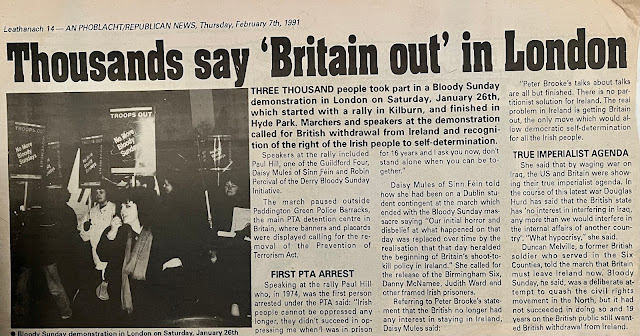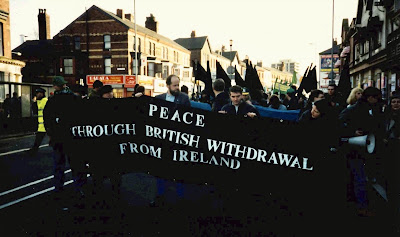On the occasion of Queen Elizabeth's Diamond Jubilee, I am reminded of James Connolly's denunciation of Queen Victoria's Diamond Jubilee in 1897:
'“The great appear great to us, only because we are on our knees: LET US RISE.”
Fellow Workers, The loyal subjects of Victoria, Queen of Great Britain and Ireland, Empress of India, etc., celebrate this year the longest reign on record. Already the air is laden with rumours of preparations for a wholesale manufacture of sham ‘popular rejoicings’ at this glorious (?) commemoration. Home Rule orators and Nationalist Lord Mayors, Whig politicians and Parnellite pressmen, have ere now lent their prestige and influence to the attempt to arouse public interest in the sickening details of this Feast of Flunkeyism...
During this glorious reign Ireland has seen 1,225,000 of her children die of famine, starved to death whilst the produce of her soil and their labour was eaten up by a vulture aristocracy, enforcing their rents by the bayonets of a hired assassin army in the pay of the –best of the English Queens’; the eviction of 3,668,000, a multitude greater than the entire population of Switzerland; and the reluctant emigration of 4,186,000 of our kindred, a greater host than the entire people of Greece. At the present moment 78 percent of our wage-earners receive less than £1 per week, our streets are thronged by starving crowds of the unemployed, cattle graze on our tenantless farms and around the ruins of our battered homesteads, our ports are crowded with departing emigrants, and our poorhouses are full of paupers. Such are the constituent elements out of which we are bade to construct a National Festival of rejoicing!'.
Connolly goes on: 'To you, workers of Ireland, we address ourselves. AGITATE in the workshop, in the field, in the factory, until you arouse your brothers to hatred of the slavery of which we are all the victims. EDUCATE, that the people may no longer be deluded by illusory hopes of prosperity under any system of society of which monarchs or noblemen, capitalists or landlords form an integral part. ORGANISE, that a solid, compact and intelligent force, conscious of your historic mission as a class, you may seize the reins of political power whenever possible and, by intelligent application of the working-class ballot, clear the field of action for the revolutionary forces of the future. Let the ‘canting, fed classes’ bow the knee as they may, be you true to your own manhood, and to the cause of freedom, whose hope is in you, and, pressing unweariedly onward in pursuit of the high destiny to which the Socialist Republic invites you' (full text here).
Agitate, Educate and Organise
I am intrigued by Connolly's use of the Agitate, Educate, Organise meme, a phrase that became common in 20th century radicalism. I wonder about its origins - the earliest reference I have found is from 1882, when the Knights of Labor (a trade union) held what was in effect the first Labor Day parade in New York: 'on Sep 15, 1882, a handful of laborers, organized by Peter McGuire, began a march uptown through lower Manhattan, carrying signs that read Agitate, Educate, Organize and Less Work, More Pay. Mocked by fashionable New Yorkers they continued their trek as more and more laboring men, women, and children joined them. By the time they reached what is now called Union Square, there were over 10,000 strong and cheered by thousands more in the Square. It was the first real Labor Day' (article here). Irish emigrants played a key role in the formation of the Knights of Labor, and later Connolly himself became involved in US radical politics in the 1900s.
Of course the phrase made its way on to 1980s dancefloors via 'How we gonna make the black nation rise' ('we're gonna agitate, educate and organize') by Brother D with The Collective Effort (1980) - one of the earliest explicitly political rap tracks.
In 1987, Irish band (with American singer) That Petrol Emotion used the phrase in their track 'Big Decision' with its rap section 'What you`ve gotta do In this day and age. You gotta agitate, educate, organize'. The track was no doubt influenced more by Brother D than Connolly, but its references to the use of plastic bullets in Ireland put the band in Connolly's republican tradition.
'“The great appear great to us, only because we are on our knees: LET US RISE.”
Fellow Workers, The loyal subjects of Victoria, Queen of Great Britain and Ireland, Empress of India, etc., celebrate this year the longest reign on record. Already the air is laden with rumours of preparations for a wholesale manufacture of sham ‘popular rejoicings’ at this glorious (?) commemoration. Home Rule orators and Nationalist Lord Mayors, Whig politicians and Parnellite pressmen, have ere now lent their prestige and influence to the attempt to arouse public interest in the sickening details of this Feast of Flunkeyism...
During this glorious reign Ireland has seen 1,225,000 of her children die of famine, starved to death whilst the produce of her soil and their labour was eaten up by a vulture aristocracy, enforcing their rents by the bayonets of a hired assassin army in the pay of the –best of the English Queens’; the eviction of 3,668,000, a multitude greater than the entire population of Switzerland; and the reluctant emigration of 4,186,000 of our kindred, a greater host than the entire people of Greece. At the present moment 78 percent of our wage-earners receive less than £1 per week, our streets are thronged by starving crowds of the unemployed, cattle graze on our tenantless farms and around the ruins of our battered homesteads, our ports are crowded with departing emigrants, and our poorhouses are full of paupers. Such are the constituent elements out of which we are bade to construct a National Festival of rejoicing!'.
Connolly goes on: 'To you, workers of Ireland, we address ourselves. AGITATE in the workshop, in the field, in the factory, until you arouse your brothers to hatred of the slavery of which we are all the victims. EDUCATE, that the people may no longer be deluded by illusory hopes of prosperity under any system of society of which monarchs or noblemen, capitalists or landlords form an integral part. ORGANISE, that a solid, compact and intelligent force, conscious of your historic mission as a class, you may seize the reins of political power whenever possible and, by intelligent application of the working-class ballot, clear the field of action for the revolutionary forces of the future. Let the ‘canting, fed classes’ bow the knee as they may, be you true to your own manhood, and to the cause of freedom, whose hope is in you, and, pressing unweariedly onward in pursuit of the high destiny to which the Socialist Republic invites you' (full text here).
Agitate, Educate and Organise
I am intrigued by Connolly's use of the Agitate, Educate, Organise meme, a phrase that became common in 20th century radicalism. I wonder about its origins - the earliest reference I have found is from 1882, when the Knights of Labor (a trade union) held what was in effect the first Labor Day parade in New York: 'on Sep 15, 1882, a handful of laborers, organized by Peter McGuire, began a march uptown through lower Manhattan, carrying signs that read Agitate, Educate, Organize and Less Work, More Pay. Mocked by fashionable New Yorkers they continued their trek as more and more laboring men, women, and children joined them. By the time they reached what is now called Union Square, there were over 10,000 strong and cheered by thousands more in the Square. It was the first real Labor Day' (article here). Irish emigrants played a key role in the formation of the Knights of Labor, and later Connolly himself became involved in US radical politics in the 1900s.
Of course the phrase made its way on to 1980s dancefloors via 'How we gonna make the black nation rise' ('we're gonna agitate, educate and organize') by Brother D with The Collective Effort (1980) - one of the earliest explicitly political rap tracks.
In 1987, Irish band (with American singer) That Petrol Emotion used the phrase in their track 'Big Decision' with its rap section 'What you`ve gotta do In this day and age. You gotta agitate, educate, organize'. The track was no doubt influenced more by Brother D than Connolly, but its references to the use of plastic bullets in Ireland put the band in Connolly's republican tradition.
































